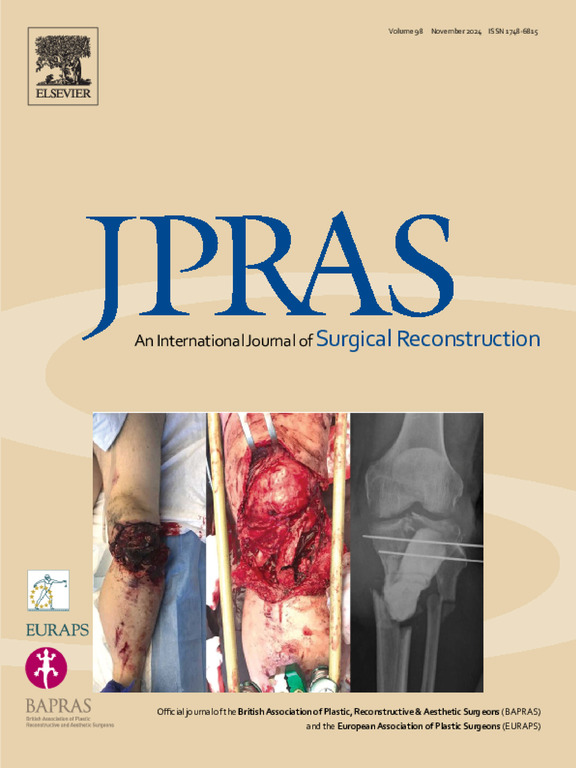非烟草尼古丁使用对缩乳术后并发症的影响:倾向评分匹配分析。
IF 2.4
3区 医学
Q2 SURGERY
Journal of Plastic Reconstructive and Aesthetic Surgery
Pub Date : 2025-08-29
DOI:10.1016/j.bjps.2025.08.030
引用次数: 0
摘要
背景:巨乳症对生活质量产生负面影响,并导致缩胸手术的需求增加。随着非烟草尼古丁产品(如电子烟)的使用越来越多,人们开始担心它们对术后结果的潜在影响。本研究旨在探讨非烟草尼古丁依赖(NTND)是否与缩乳术后并发症风险增加有关。方法:查询TriNetX数据库以确定行缩乳手术的患者。根据NTND的诊断将患者分为2组,不包括有烟草使用或依赖的患者。进行倾向评分匹配分析以调整与术后并发症相关的危险因素。主要结局是伤口裂开,次要结局包括手术部位感染、血肿、血肿、阿片类药物使用和急诊就诊。在手术后30、60和90天评估所有结果。结果:配对后,每组共2327人。与没有NTND的患者相比,NTND患者在缩乳后30天发生伤口裂开(风险比[RR] 1.97, p = 0.001)、阿片类药物使用(RR 1.35, p < 0.001)和急诊科就诊(RR 1.39, p = 0.006)的风险显著增加。在手术后60天和90天观察到类似的风险增加。在任何时间点,手术部位感染、血肿或血肿在两组之间均无显著差异。结论:在这项研究中,NTND与缩胸手术后伤口裂开、急诊就诊和阿片类药物使用的风险增加有关。本文章由计算机程序翻译,如有差异,请以英文原文为准。
Impact of non-tobacco nicotine use on postoperative complications in breast reduction: A propensity score-matched analysis
Background
Macromastia negatively affects the quality of life and has led to increased demand for breast reduction surgery. With the growing use of non-tobacco nicotine products, such as vapes, concerns have emerged about their potential impact on postoperative outcomes. This study aims to investigate whether non-tobacco nicotine dependence (NTND) is associated with an increased risk of postoperative complications following breast reduction.
Methods
The TriNetX database was queried to identify patients who underwent breast reduction. Patients were classified into 2 cohorts based on the diagnosis of NTND, excluding those with tobacco use or dependence. A propensity score-matching analysis was performed to adjust for risk factors associated with postoperative complications. The primary outcome was wound dehiscence, while secondary outcomes included surgical site infection, hematoma, seroma, opioid use, and emergency department visits. All outcomes were assessed at 30, 60, and 90 days following surgery.
Results
After matching, each group contained 2327 individuals. Patients with NTND had a significantly increased risk of wound dehiscence (risk ratio [RR] 1.97, p = 0.001), opioid use (RR 1.35, p < 0.001), and emergency department visits (RR 1.39, p = 0.006) at 30 days after breast reduction, compared to patients without NTND. Similar increases in risk were observed at 60 and 90 days after surgery. No significant differences were observed between the groups for surgical site infection, hematoma, or seroma at any time point.
Conclusion
In this study, NTND is associated with an increased risk of wound dehiscence, emergency department visits, and opioid use following breast reduction surgery.
求助全文
通过发布文献求助,成功后即可免费获取论文全文。
去求助
来源期刊
CiteScore
3.10
自引率
11.10%
发文量
578
审稿时长
3.5 months
期刊介绍:
JPRAS An International Journal of Surgical Reconstruction is one of the world''s leading international journals, covering all the reconstructive and aesthetic aspects of plastic surgery.
The journal presents the latest surgical procedures with audit and outcome studies of new and established techniques in plastic surgery including: cleft lip and palate and other heads and neck surgery, hand surgery, lower limb trauma, burns, skin cancer, breast surgery and aesthetic surgery.

 求助内容:
求助内容: 应助结果提醒方式:
应助结果提醒方式:


